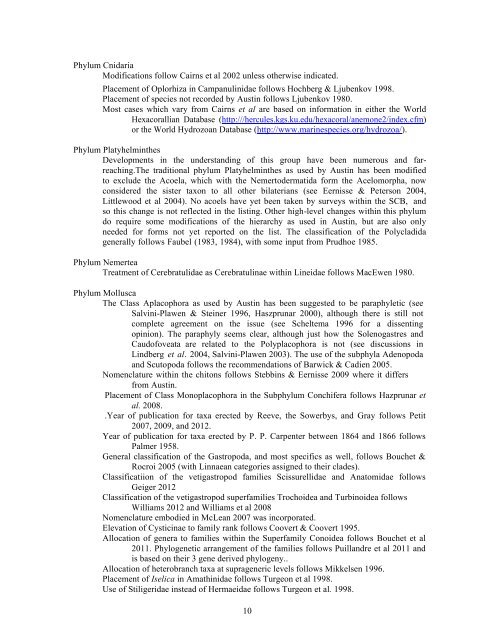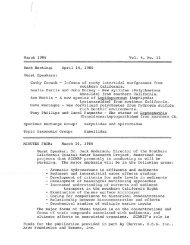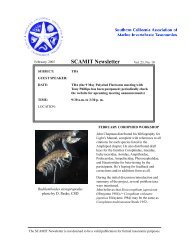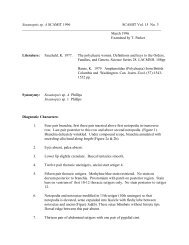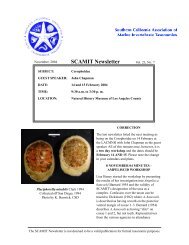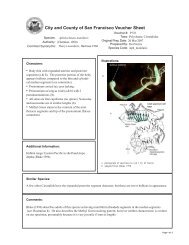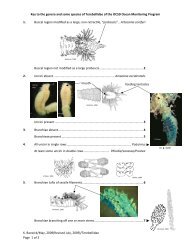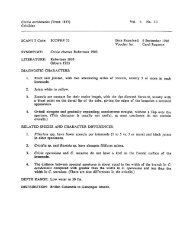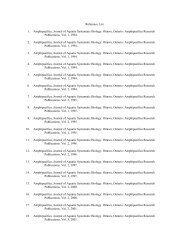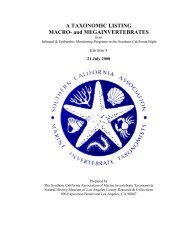A Taxonomic Listing of Benthic Macro- and Megainvertebrates - scamit
A Taxonomic Listing of Benthic Macro- and Megainvertebrates - scamit
A Taxonomic Listing of Benthic Macro- and Megainvertebrates - scamit
- No tags were found...
You also want an ePaper? Increase the reach of your titles
YUMPU automatically turns print PDFs into web optimized ePapers that Google loves.
Phylum Cnidaria<br />
Modifications follow Cairns et al 2002 unless otherwise indicated.<br />
Placement <strong>of</strong> Oplorhiza in Campanulinidae follows Hochberg & Ljubenkov 1998.<br />
Placement <strong>of</strong> species not recorded by Austin follows Ljubenkov 1980.<br />
Most cases which vary from Cairns et al are based on information in either the World<br />
Hexacorallian Database (http:///hercules.kgs.ku.edu/hexacoral/anemone2/index.cfm)<br />
or the World Hydrozoan Database (http://www.marinespecies.org/hydrozoa/).<br />
Phylum Platyhelminthes<br />
Developments in the underst<strong>and</strong>ing <strong>of</strong> this group have been numerous <strong>and</strong> farreaching.The<br />
traditional phylum Platyhelminthes as used by Austin has been modified<br />
to exclude the Acoela, which with the Nemertodermatida form the Acelomorpha, now<br />
considered the sister taxon to all other bilaterians (see Eernisse & Peterson 2004,<br />
Littlewood et al 2004). No acoels have yet been taken by surveys within the SCB, <strong>and</strong><br />
so this change is not reflected in the listing. Other high-level changes within this phylum<br />
do require some modifications <strong>of</strong> the hierarchy as used in Austin, but are also only<br />
needed for forms not yet reported on the list. The classification <strong>of</strong> the Polycladida<br />
generally follows Faubel (1983, 1984), with some input from Prudhoe 1985.<br />
Phylum Nemertea<br />
Treatment <strong>of</strong> Cerebratulidae as Cerebratulinae within Lineidae follows MacEwen 1980.<br />
Phylum Mollusca<br />
The Class Aplacophora as used by Austin has been suggested to be paraphyletic (see<br />
Salvini-Plawen & Steiner 1996, Haszprunar 2000), although there is still not<br />
complete agreement on the issue (see Scheltema 1996 for a dissenting<br />
opinion). The paraphyly seems clear, although just how the Solenogastres <strong>and</strong><br />
Caud<strong>of</strong>oveata are related to the Polyplacophora is not (see discussions in<br />
Lindberg et al. 2004, Salvini-Plawen 2003). The use <strong>of</strong> the subphyla Adenopoda<br />
<strong>and</strong> Scutopoda follows the recommendations <strong>of</strong> Barwick & Cadien 2005.<br />
Nomenclature within the chitons follows Stebbins & Eernisse 2009 where it differs<br />
from Austin.<br />
Placement <strong>of</strong> Class Monoplacophora in the Subphylum Conchifera follows Hazprunar et<br />
al. 2008.<br />
.Year <strong>of</strong> publication for taxa erected by Reeve, the Sowerbys, <strong>and</strong> Gray follows Petit<br />
2007, 2009, <strong>and</strong> 2012.<br />
Year <strong>of</strong> publication for taxa erected by P. P. Carpenter between 1864 <strong>and</strong> 1866 follows<br />
Palmer 1958.<br />
General classification <strong>of</strong> the Gastropoda, <strong>and</strong> most specifics as well, follows Bouchet &<br />
Rocroi 2005 (with Linnaean categories assigned to their clades).<br />
Classificatiion <strong>of</strong> the vetigastropod families Scissurellidae <strong>and</strong> Anatomidae follows<br />
Geiger 2012<br />
Classification <strong>of</strong> the vetigastropod superfamilies Trochoidea <strong>and</strong> Turbinoidea follows<br />
Williams 2012 <strong>and</strong> Williams et al 2008<br />
Nomenclature embodied in McLean 2007 was incorporated.<br />
Elevation <strong>of</strong> Cysticinae to family rank follows Coovert & Coovert 1995.<br />
Allocation <strong>of</strong> genera to families within the Superfamily Conoidea follows Bouchet et al<br />
2011. Phylogenetic arrangement <strong>of</strong> the families follows Puill<strong>and</strong>re et al 2011 <strong>and</strong><br />
is based on their 3 gene derived phylogeny..<br />
Allocation <strong>of</strong> heterobranch taxa at suprageneric levels follows Mikkelsen 1996.<br />
Placement <strong>of</strong> Iselica in Amathinidae follows Turgeon et al 1998.<br />
Use <strong>of</strong> Stiligeridae instead <strong>of</strong> Hermaeidae follows Turgeon et al. 1998.<br />
10


